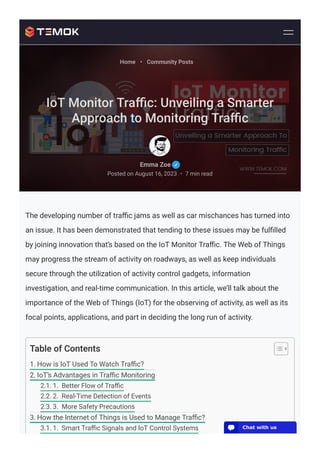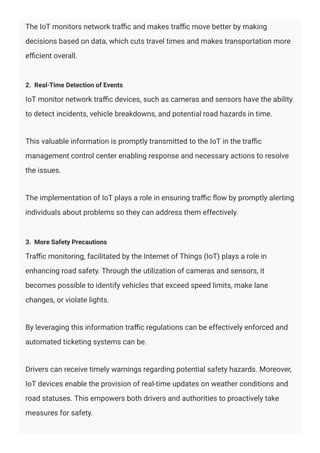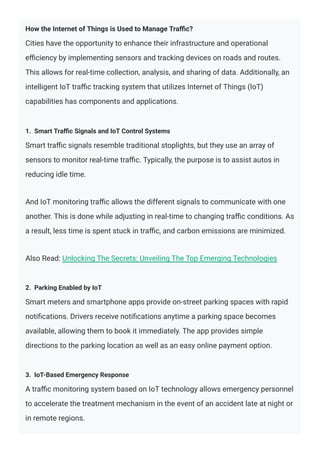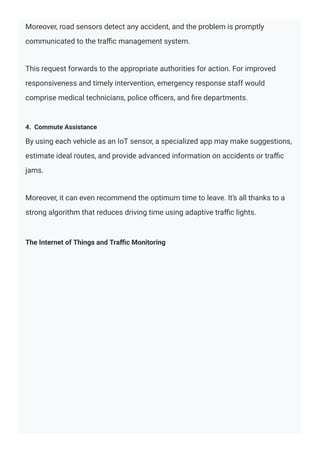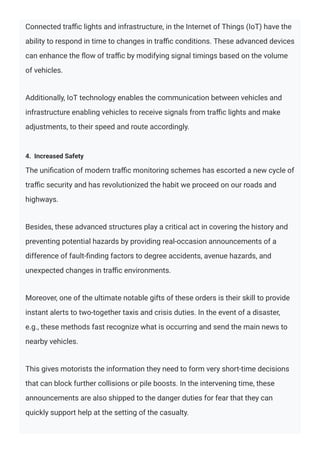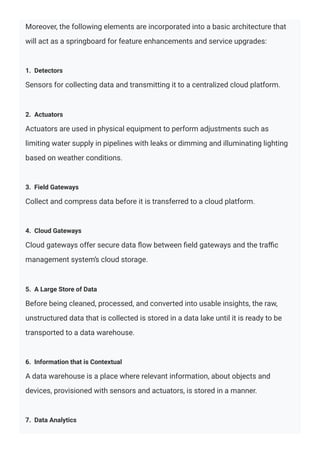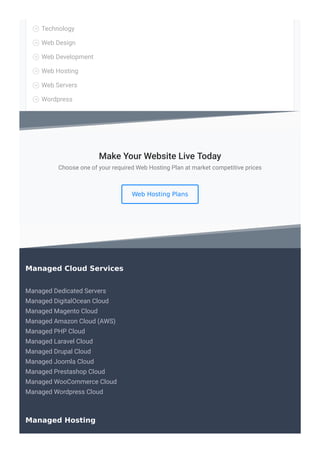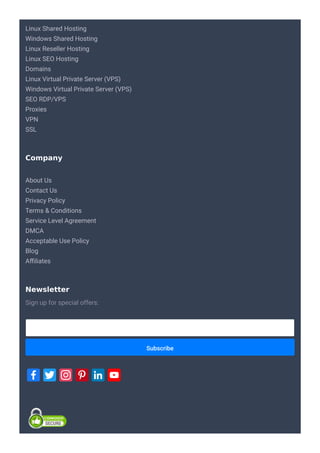IoT Monitor Traffic: Unveiling a Smarter Approach to Monitoring Traffic
- 1. The developing number of traffic jams as well as car mischances has turned into an issue. It has been demonstrated that tending to these issues may be fulfilled by joining innovation that’s based on the IoT Monitor Traffic. The Web of Things may progress the stream of activity on roadways, as well as keep individuals secure through the utilization of activity control gadgets, information investigation, and real-time communication. In this article, we’ll talk about the importance of the Web of Things (IoT) for the observing of activity, as well as its focal points, applications, and part in deciding the long run of activity. Table of Contents 1. How is IoT Used To Watch Traffic? 2. IoT’s Advantages in Traffic Monitoring 2.1. 1. Better Flow of Traffic 2.2. 2. Real-Time Detection of Events 2.3. 3. More Safety Precautions 3. How the Internet of Things is Used to Manage Traffic? 3.1. 1. Smart Traffic Signals and IoT Control Systems Emma Zoe Posted on August 16, 2023 7 min read • Home • Community Posts IoT Monitor Traffic: Unveiling a Smarter Approach to Monitoring Traffic 💬 Chat with us
- 2. How is IoT Used To Watch Traffic? This advanced system consists of components, including sensors, RFID tags, and BLE beacons that are strategically placed at traffic lights to monitor the flow of vehicles. Real-time data analytics tools enable control rooms to connect with a map integrated with a Geographic Information System (GIS) facilitating real-time monitoring of traffic. The intelligent traffic control system captures images of vehicles at the traffic lights using a process called ” image processing.” Subsequently, this information is transmitted to the control room via devices. BLE beacons or RFID tags track vehicle movements, minimizing road congestion. RFID readers can help locate stolen automobiles and create emergency vehicle routes. 3.2. 2. Parking Enabled by IoT 3.3. 3. IoT-Based Emergency Response 3.4. 4. Commute Assistance 4. The Internet of Things and Traffic Monitoring 4.1. 1. Data Collection in Real Time 4.2. 2. Analytics Predictive 4.3. 3. IoT-Connected Traffic Lights and Infrastructure 4.4. 4. Increased Safety 4.5. 5. Policy Decisions Based on Data 5. Smart Traffic Management System Implementation 5.1. 1. Detectors 5.2. 2. Actuators 5.3. 3. Field Gateways 5.4. 4. Cloud Gateways 5.5. 5. A Large Store of Data 5.6. 6. Information that is Contextual 5.7. 7. Data Analytics 6. Conclusion: IoT Monitor Traffic: Unveiling a Smarter Approach to Monitoring Traffic
- 3. IoT’s Advantages in Traffic Monitoring Utilizing the IoT in traffic management monitoring aids in enhancing the flow of traffic promptly identifying issues and ensuring road safety for drivers. This contributes to improved efficiency in transportation systems and enhances overall driver well-being, on the roads. 1. Better Flow of Traffic Thanks to the Internet of Things we can now. Analyze real-time traffic data. These allow authorities to monitor traffic patterns and identify areas with congestion. However, this information can be utilized to enhance the synchronization of traffic signals, provide flexibility in lane control and propose methods for navigating through congested areas.
- 4. The IoT monitors network traffic and makes traffic move better by making decisions based on data, which cuts travel times and makes transportation more efficient overall. 2. Real-Time Detection of Events IoT monitor network traffic devices, such as cameras and sensors have the ability to detect incidents, vehicle breakdowns, and potential road hazards in time. This valuable information is promptly transmitted to the IoT in the traffic management control center enabling response and necessary actions to resolve the issues. The implementation of IoT plays a role in ensuring traffic flow by promptly alerting individuals about problems so they can address them effectively. 3. More Safety Precautions Traffic monitoring, facilitated by the Internet of Things (IoT) plays a role in enhancing road safety. Through the utilization of cameras and sensors, it becomes possible to identify vehicles that exceed speed limits, make lane changes, or violate lights. By leveraging this information traffic regulations can be effectively enforced and automated ticketing systems can be. Drivers can receive timely warnings regarding potential safety hazards. Moreover, IoT devices enable the provision of real-time updates on weather conditions and road statuses. This empowers both drivers and authorities to proactively take measures for safety.
- 5. How the Internet of Things is Used to Manage Traffic? Cities have the opportunity to enhance their infrastructure and operational efficiency by implementing sensors and tracking devices on roads and routes. This allows for real-time collection, analysis, and sharing of data. Additionally, an intelligent IoT traffic tracking system that utilizes Internet of Things (IoT) capabilities has components and applications. 1. Smart Traffic Signals and IoT Control Systems Smart traffic signals resemble traditional stoplights, but they use an array of sensors to monitor real-time traffic. Typically, the purpose is to assist autos in reducing idle time. And IoT monitoring traffic allows the different signals to communicate with one another. This is done while adjusting in real-time to changing traffic conditions. As a result, less time is spent stuck in traffic, and carbon emissions are minimized. Also Read: Unlocking The Secrets: Unveiling The Top Emerging Technologies 2. Parking Enabled by IoT Smart meters and smartphone apps provide on-street parking spaces with rapid notifications. Drivers receive notifications anytime a parking space becomes available, allowing them to book it immediately. The app provides simple directions to the parking location as well as an easy online payment option. 3. IoT-Based Emergency Response A traffic monitoring system based on IoT technology allows emergency personnel to accelerate the treatment mechanism in the event of an accident late at night or in remote regions.
- 6. Moreover, road sensors detect any accident, and the problem is promptly communicated to the traffic management system. This request forwards to the appropriate authorities for action. For improved responsiveness and timely intervention, emergency response staff would comprise medical technicians, police officers, and fire departments. 4. Commute Assistance By using each vehicle as an IoT sensor, a specialized app may make suggestions, estimate ideal routes, and provide advanced information on accidents or traffic jams. Moreover, it can even recommend the optimum time to leave. It’s all thanks to a strong algorithm that reduces driving time using adaptive traffic lights. The Internet of Things and Traffic Monitoring
- 7. The Internet of Things (IoT) has brought about changes, in sectors, including traffic monitoring, which stands to gain immensely from this technology. Moreover, by leveraging devices we can revolutionize how we manage traffic by accessing real-time data and valuable insights. This can result in transportation systems and improved safety measures. 1. Data Collection in Real Time Sensors and cameras of the Internet of Things (IoT) can be strategically positioned across streets, intersections, and highways to capture traffic information. This information encompasses vehicle movement, speed, congestion levels, and even weather conditions. By collecting and analyzing this data in time traffic management authorities can promptly make decisions. 2. Analytics Predictive Traffic monitoring systems have the ability to use analytics through technology to predict IoT monitor traffic patterns. Moreover, by examining current data these systems can anticipate areas where congestion may occur and provide routes, for vehicles. This not decreases travel times. Also helps reduce the negative environmental effects caused by traffic congestion. 3. IoT-Connected Traffic Lights and Infrastructure
- 8. Connected traffic lights and infrastructure, in the Internet of Things (IoT) have the ability to respond in time to changes in traffic conditions. These advanced devices can enhance the flow of traffic by modifying signal timings based on the volume of vehicles. Additionally, IoT technology enables the communication between vehicles and infrastructure enabling vehicles to receive signals from traffic lights and make adjustments, to their speed and route accordingly. 4. Increased Safety The unification of modern traffic monitoring schemes has escorted a new cycle of traffic security and has revolutionized the habit we proceed on our roads and highways. Besides, these advanced structures play a critical act in covering the history and preventing potential hazards by providing real-occasion announcements of a difference of fault-finding factors to degree accidents, avenue hazards, and unexpected changes in traffic environments. Moreover, one of the ultimate notable gifts of these orders is their skill to provide instant alerts to two-together taxis and crisis duties. In the event of a disaster, e.g., these methods fast recognize what is occurring and send the main news to nearby vehicles. This gives motorists the information they need to form very short-time decisions that can block further collisions or pile boosts. In the intervening time, these announcements are also shipped to the danger duties for fear that they can quickly support help at the setting of the casualty.
- 9. 5. Policy Decisions Based on Data Urban planners and policymakers can benefit from the amount of data collected by devices. Moreover, this data use to make decisions by analyzing traffic patterns. Additionally, It enables authorities to create road networks, allocate resources efficiently and implement interventions that address traffic-related issues effectively. Also Read: Smarter Devices — A Look into the Future Smart Traffic Management System Implementation Here’s a plan for putting together a scalable traffic control system that takes advantage of IoT monitor network traffic capabilities:
- 10. Moreover, the following elements are incorporated into a basic architecture that will act as a springboard for feature enhancements and service upgrades: 1. Detectors Sensors for collecting data and transmitting it to a centralized cloud platform. 2. Actuators Actuators are used in physical equipment to perform adjustments such as limiting water supply in pipelines with leaks or dimming and illuminating lighting based on weather conditions. 3. Field Gateways Collect and compress data before it is transferred to a cloud platform. 4. Cloud Gateways Cloud gateways offer secure data flow between field gateways and the traffic management system’s cloud storage. 5. A Large Store of Data Before being cleaned, processed, and converted into usable insights, the raw, unstructured data that is collected is stored in a data lake until it is ready to be transported to a data warehouse. 6. Information that is Contextual A data warehouse is a place where relevant information, about objects and devices, provisioned with sensors and actuators, is stored in a manner. 7. Data Analytics
- 11. Analyzing data gathered from sensors. Presenting it on a single dashboard allows for the adjustment of emitted light levels. Conclusion: IoT Monitor Traffic: Unveiling a Smarter Approach to Monitoring Traffic The Internet of Things (IoT) plays a role, in revolutionizing traffic monitoring. By combining sensors, devices, and data analysis these systems provide real-time insights into traffic patterns. Besides, this enables the allocation of resources as well as improved urban planning. The concept of using IoT to monitor traffic focuses on the connection between connectivity and traffic management. These measures do not enhance safety. Also, reduce congestion and support the long-term growth of cities. Moreover, as technology progresses leveraging the potential of IoT, in monitoring traffic can make cities worldwide smarter and more livable. This integration of innovation and urban planning showcases how IoT has the power to shape our environment. Register your domain name, get a web hosting plan, and have a skilled team of web developers make a website with advanced features for your business. Ask our hosting advisors about the best solution. Schedule a call for service! Emma Zoe • August 16, 2023 0
- 12. Show Comments Blog Categories Before anyone else does Register Now Register Your Domain Get the latest news and deals Join our subscribers list to receive latest blogs, updates and special offers delivered directly in your inbox. Your Name john.doe@gmail.com join the list
- 13. App App Marketing Backup & Security Cloud Hosting Cloud Services CMS Content Content Marketing Databases Dedicated Servers Digital Marketing Domains E-Commerce Education Entrepreneurship Infographic Linux Metaverse Misc Mobile App Development Networking NFTs Proxy Sales & Marketing Search Engine Optimization Servers Social Media Technical Interviews
- 14. Technology Web Design Web Development Web Hosting Web Servers Wordpress Choose one of your required Web Hosting Plan at market competitive prices Web Hosting Plans Make Your Website Live Today Managed Dedicated Servers Managed DigitalOcean Cloud Managed Magento Cloud Managed Amazon Cloud (AWS) Managed PHP Cloud Managed Laravel Cloud Managed Drupal Cloud Managed Joomla Cloud Managed Prestashop Cloud Managed WooCommerce Cloud Managed Wordpress Cloud Managed Cloud Services Managed Hosting
- 15. Linux Shared Hosting Windows Shared Hosting Linux Reseller Hosting Linux SEO Hosting Domains Linux Virtual Private Server (VPS) Windows Virtual Private Server (VPS) SEO RDP/VPS Proxies VPN SSL About Us Contact Us Privacy Policy Terms & Conditions Service Level Agreement DMCA Acceptable Use Policy Blog Affiliates Company Subscribe Sign up for special offers: Newsletter
- 16. © Copyright TEMOK 2023. All Rights Reserved.
